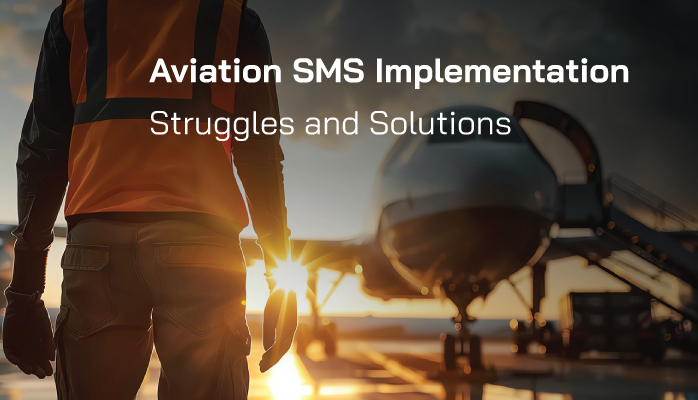Conforming Aviation SMS Around Struggles

Aviation safety management systems (SMS) are now an FAA requirement for part 121 certificated operators.
Without having a verifiable SMS, operators will face denial of permits and other problems. For organizations that have only lightly dabbled with an SMS and do not have a demonstrable program, they are now tasked with three things:
- Beginning SMS implementation;
- Understanding current struggles impeding successful implementation; and
- Identifying the proper solutions.
Implementing an aviation SMS is a huge undertaking. Simply put, it tasks SMS managers with assembling an entire organization towards a single focus – a focus that is overflowing with
- procedures,
- policies,
- bureaucracy,
- behaviors,
- a mindset, and
- a culture.
Related Aviation SMS Implementation Articles
- Why Should We Implement Aviation SMS?
- 3 Myths About Aviation SMS Implementation
- How to Create Aviation SMS Implementation Plan - With Templates
Full aviation SMS implementations often take 3-5 years and have four different phases. Managers need to frequently evaluate to know which phase of SMS implementation they are in. Do you know which implementation phase you are in?
Safety managers and accountable executives alike tend to believe they are further along in their SMS implementations than they truly are. This may be one of those "wishful thinking" or "my baby is so special" phenomena that blind so many of us at one time or another.
There are surveys online available to help you quickly evaluate which SMS implementation phase you are in. Below are four, fast, easy-to-use assessments. If you believe your SMS is currently in phase three or four, then choose the assessment for the one immediately below where you believe your SMS is now. For example, if you believe you are in phase four, then choose the phase three SMS implementation assessment.
- SMS Implementation Assessment for Phase 1
- SMS Implementation Assessment for Phase 2
- SMS Implementation Assessment for Phase 3
- SMS Implementation Assessment for Phase 4
Regardless of which phase of implementation an SMS is in, they tend to share similar types of problems.
Value of SMS

One of the most common challenges aviation SMS constantly struggles with at every phase of aviation SMS implementation is resistance due to employees and management who do not value their organization’s SMS. The toughest audience in the room will be the old-school operational department heads who have been doing business the same way forever! And they don't want to change.
Old-school managers have seen the traditional safety programs. And since they were managers, there really was no expectation for these managers to participate in the safety program. This has changed! All process owners and operational department heads are now expected to actively participate in the SMS. As they should!
It makes little sense for line-level employees to report safety concerns when management is not actively involved in reviewing the affected systems. Who else in the company knows these affected systems better than process owners and operational department heads? These managers understand the systems'
- hazards,
- risks, and
- risk controls.
Since these process owners and subject matter experts understand how these complex systems operate, managers need to be involved in improving processes and procedures to reduce risk to as low as reasonably practical. These resistant department heads are as vital to SMS as are the line-level employees who are monitoring the systems.
Overcoming resistance in aviation SMS is a big topic, and we periodically cover it. Successful solutions generally fall into two categories:
- Promotion and training to educate employees and management; and
- Resources and guidance from the experience of more experienced operators on how to instill the value of SMS in the company’s safety culture.
The exact type of promotion, training, and guidance will differ from organization to organization and from the implementation phase to the implementation phase.
Related Aviation SMS Implementation Articles
- Is Your Aviation SMS Implementation Performing or Prescriptive?
- 4 Management Failures That Kill Aviation SMS Implementations
- SMS First Steps - How to Create an SMS Implementation Plan
Lack of Management’s Implementation Know How
On the management side of SMS implementation, every manager will get to a point in implementation, whether sooner or later, where they are “treading in new water.” Which is to say that they lack the practical operational and corporate experience to understand the needed processes and procedures for furthering the aviation SMS implementation.
For this problem, common solutions are to seek a veteran SMS expert who can:
- Seek out hands-on training of SMS implementation from aviation oversight agencies, other carriers, etc.;
- Analysis and determination of the aviation SMS' most specific needs, and how they fall short of specific requirements (i.e. gap analysis);
- Focus on customizing an SMS implementation to specific needs of the organization's goals and objectives, rather than the “prescriptive” compliance-focused SMS; and
- Create a road map with step-by-step instructions.
SMS experts help ground safety managers in the realities of where their SMS implementation is, what it needs, and how to get there.
Efficient and Timely Implementation

Consistent effort toward SMS implementation progress and continual improvement of the SMS on the part of safety managers will eventually lead to full implementation. But there are efficient and timely ways of implementing an SMS, and a more disorganized, chaotic approach.
The ability to be organized cannot be understated. A common challenge faced by MANY accountable executives and safety teams is "How do we manage the data?" What are the SMS documentation requirements? Can I do this using spreadsheets? Or do I need special tools?
While you don't need anything more than spreadsheets and email as your SMS data management strategy, this is not our recommendation. If you have more than 100 employees, then you should get a low-cost, commercially available SMS database. These SMS databases have been built specifically to address the SMS documentation requirements.
You could choose to build data management systems in-house. To do this, you will need these common SMS data management systems, depending on the size and complexity of your operations:
- Safety reporting system;
- Risk management system;
- Auditing system;
- SMS training management system;
- Safety goals and objectives tracking system;
- Safety promotion system;
- SMS implementation management system;
- Vendor management system; and
- SMS performance monitoring system.
There is no requirement that you have to have a sophisticated SMS database. Very small companies can get by using spreadsheets and email.
Your SMS data management strategy is very important. Regardless of whether you have a manual data management process or aviation SMS software, you should choose a system that is:
- Centralized data storage In one place: options to store documentation that everyone has access to;
- Easy to access: real-time data access, such as using the Web;
- Easy to use: intuitive, guided interface;
- Comprehensive: incorporates all elements of ICAO SMS documentation requirements;
- Flexible and manageable: configurable, security-based options; and
- Fully operational: covers the needs of an entire SMS, from managing SMS implementation requirements to monitoring SMS performance during the final operational safety assurance phase.
Using templated SMS manuals or pre-built aviation safety software ensures that such management tools are industry-developed and tested, and are a significant improvement over trying to “reinvent the wheel.” Commercially developed SMS software will save
- time,
- misguided efforts, and
- disorganization.
Related Aviation SMS Database Articles
- What Is an Aviation Safety Database
- When to Design Your Own Aviation SMS Database
- How to Choose the Best Aviation Safety Database Software
Lack of Resources for Implementing SMS

Lack of resources for implementing aviation SMS comes in several different forms:
Proper financial resources to actively manage the SMS
A common problem that impedes safety managers from acquiring proper SMS data management tools is lack of:
- financial and human resources; or
- management support.
Usually financial resources/support are what safety managers lack the most often. There are no easy answers here: it generally takes persistent championing (and wearing down of resistance) for specific resources and tools.
Safety managers have to ensure that the organization's goals and objectives align with the organization's safety goals and objectives. Some companies do not need a sustainable SMS. They only need to implement a "paper SMS" to achieve their immediate business goals.
In these cases where an operator simply needs to "check the box," one finds it difficult to argue the business case for spending too much time and money on an SMS implementation, when there will be little effective oversight or the company only, needs to demonstrate a functioning SMS to acquire a particular business contract. While nobody likes to believe this happens, there is no arguing that it happens.
Inability to demonstrate SMS implementation and conformance to standards
Referring the program to third-party auditors for standards, or doing internal audits with auditing templates and resources will help a program identify where and why it can’t demonstrate conformance.
Inability to qualify the maturity of SMS
Often, the inability to qualify the maturity of an SMS is a symptom of poorly considered, poorly clarified, or unrealistic performance benchmarks standards. Being able to say with absolute assurance that “THIS is where the SMS implementation is at” requires very specific, incremental benchmarks to measure performance against.
Having resources for specific data analysis and data mining is required to establish where the SMS implementation is and what the next steps are. An SMS database is useful to track and monitor SMS implementations.
Related Aviation SMS Implementation Articles
- Is Your Aviation SMS Implementation a Farce? - With Self-Assessments
- How to Start an Aviation SMS Implementation - With Resources
- Your Top 4 Risks to Aviation Safety Management System Implementations
Final Thought: Too Optimistic Implementation Phase
This is a struggle we often encounter: safety managers think that they are in phase 3 of implementation when in reality they are somewhere in between phase 2 and phase 3. Being overconfident about the phase of implementation is the same as being out of tune with what the SMS needs.
Fortunately, when in doubt, there are many resources to help with all manner of problems:
- SMS experts;
- Aviation Safety Management System software;
- Implementation tools; and
- Auditing tools and organizations.
To accurately assess the implementation needs of an SMS, it requires taking an objective look at your SMS implementation and being totally honest about its performance – for better and worse.
Good luck with your SMS implementation.
Professional safety managers have professional SMS tools.
Have you ever been on a project where you didn't have the proper tools to do the job? It is frustrating, isn't it?
Low-cost, commercially available SMS software provides safety managers with the risk management processes as well as the data management capabilities needed to run a successful SMS implementation.
If you think your tools are inadequate, check out these short demo videos to learn whether we are a good fit for you. Since 2007, SMS Pro has been working with aviation service providers around the world. Check us out. We can help.
Last updated March 2025.








